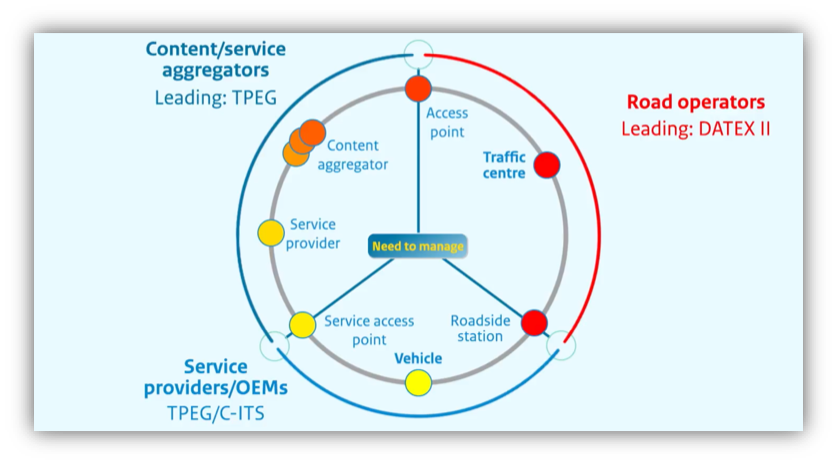The ITS world is changing. Where the information flow in the ITS value chain could formerly be presented as a linear line, technological innovations now ensure that all actors in this value chain can communicate with each other. It is therefore better to present the ITS world as a circle. All actors in the chain are affected by these changes. This is also true for DATEX II. Originally, DATEX II was focused on the requirements of highway road operators. In the past decade, service providers/OEMs also became more important. The traditional role taking in terms of traffic management and traffic information service provision is changing.
After a successful first meeting of the DATEX II Stakeholder Advisory Board (STAB) in October of 2017, we’re happy to announce that we will organize the second DATEX II STAB meeting on November 6th of 2018 in Brussels. Attendance has been confirmed by ERTICO, TISA, POLIS, Scania, TomTom, Rijkswaterstaat, DG Move, HERE, Amsterdam Group and CEDR CAD.
The main agenda item will be “the position of DATEX II in the ITS value chain”. This is a follow up of one of the recommendations from the first STAB meeting. It also matches recent developments in the traffic management domain, which can be presented as a circle with many actors, all interacting with each other. This was also discussed at the last STAB meeting and is visualized below.

This circle brings big challenges with it: data governance, consistency and reliability of information throughout the ITS value chain as information on traffic is collected in all three parts of the circle and distributed in all possible directions.
The different standards in the ITS Value Chain are designed from different perspectives and with different goals in mind. However, they often overlap as they cover the same real-world event on the road, while describing this event from different perspectives and in a different “language”. This results in the lack of a holistic view on events occurring on the road.
The 3 major roles: vehicle/road user, road operator and service providers have standards to support their operations. For seamless services that are interoperable and consistent on the information level, the interoperability of information over the interfaces needs to be guaranteed. This brings along challenges in terms of data governance and information consistency. With this in mind, we recognize that there is a role to fill for DATEX II in the “Need to manage”.
We will discuss questions such as:
- How do new technologies such as C-ITS and the future access to in vehicle data influence the traffic management domain and the roles of the different actors?
- With version 3 we are able to fulfil the needs of more stakeholders. Should DATEX II restrict itself to the road operators needs or continue to manage the needs of service providers, OEMs, content/service aggregators? To what extent?
- How do we ensure that all actors in the traffic management domain understand each other?
- How do the different organizations (such as TN-ITS, Transmodel) relate to each other?
- How do we organize that standards are interoperable?
- Whose responsibility is this?
- What role could DATEX II play herein?